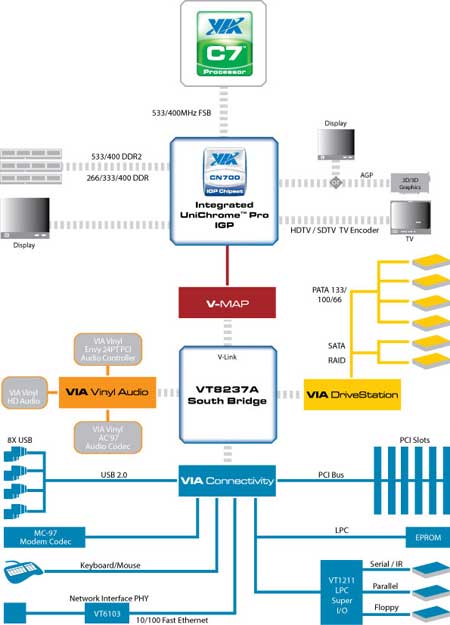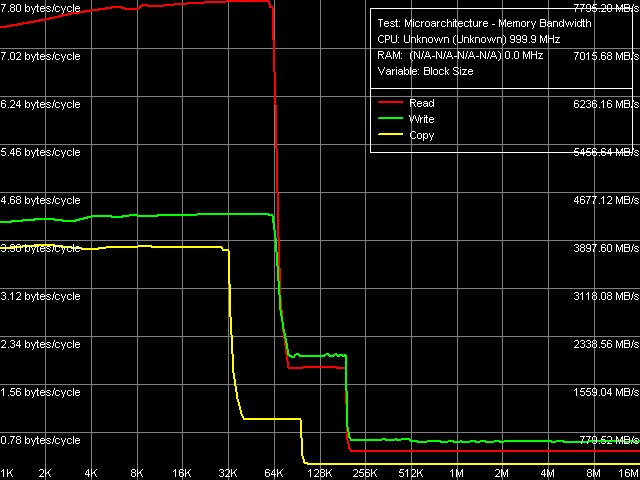MSI Fuzzy CN700 - Mini-ITX Platform Based On VIA C7
|
- VIA CN700 chipset (CN700 Northbridge, 8237R+ Southbridge)
Here we have another representative of the compact Mini-ITX form-factor (the Albatron KI51PV-754 Socket 754 board already earned our good recommendations). This time the shared heatsink covers the CPU, VIA C7 1GHz, as well. Therefore, this model is even more oriented to the embedded market (and even belongs to industrial components, according to MSI classification). But since it has easily and suspiciously quickly booted our "test" Windows XP Professional, nothing prevents us from testing it, according to our standard method.
But first let's have a look at platform's theoretical features:

Specifications make this platform look good and up-to-date, there's even the DDR2 support ("just" the DDR2-400 and 533, but the throughput fully corresponds to that of the system bus.) The set of peripheral interfaces is also modern. It's obvious that compact board developers have to choose, which features that the chipset initially supports are to be implemented and which are not.

The layout is again worthy of commendation (maybe it's common for Mini-ITX solutions, which have some of the chips situated on the back). Those few connectors and jumpers are located efficiently, and power stabilizer FETs have a dedicated heatsink that doesn't heat much even under the peak load. The primary heatsink is hotter, but still far from finger-burning state even if you apply peak load for hours without additional cooling.
The set of peripheral interfaces is more humble that that offered by Albatron's motherboard, but it still has two graphics slots. Leaving only a single IDE port is forgivable, but the exclusion of FDD connector is somewhat alarming. (The system booted perfectly from a USB dongle.) Onboard you can see a large number of chips marked "VIA", besides chipset and CPU. This includes Ethernet adapter and audio codec. MSI Fuzzy CN700 is such a demonstration of VIA's capabilities, so any fan of this company is just bound to have it :)
The single-channel CPU supply voltage pulse stabilizer features 2 x FETs, 2 x capacitors of 560 microfarad, 5 x capacitors of 1000 microfarad and 1 x capacitor of 1800 microfarad. Capacitors made by United Chemi-Con and Nichicon. The board is sized 170x170mm (Mini-ITX), fixed by 4 screws.
System monitoring (Winbond WB83627EHG, according to BIOS Setup):
- CPU core voltage, +3.3, +5, +12 V and 5 V Standby;
- 1 fan rotation speed;
- CPU and motherboard temperature measured by the respective built-in sensors.
Onboard ports, connectors, and sockets
- VIA C7 1GHz CPU in nBGA2 package; the board is officially supports processors up to 1.2GHz with 12W TDP;
- 1 x DDR2 SDRAM DIMM (up to 2GB of DDR2-400/533);
- 1 x PCI;
- 20-pin ATX 2.1 power connector;
- 1 x IDE (Parallel ATA) for 2 x ATA133 devices; provided by chipset
- 2 x SATA (Serial ATA 1.0) for 4 x SATA150; provided by chipset; supports RAID 0, 1;
- 3 x USB header connectors for 6 additional ports;
- Front-panel audio I/O connectors;
- CD/DVD audio connector;
- "Enclosure open" sensor connector;
- Wake On LAN connector;
- 1 x fan connector with rpm monitoring.
Back panel (left to right, blockwise)

Click the link to see the 3/4-view of the back panel.
- PS/2 keyboard and mouse;
- 1 x VGA, 1 x DVI;
- 1 x S-Video Out;
- 2 x USB, 1 x RJ-45 (Gigabit Ethernet);
- 2 x COM;
- Line-In, Line-Out, Mic-In.
Bundle
- Installation guide;
- 1 x SATA cabke with adapter for 1 device; 1 x ATA66 cable;
- Back-panel bracket with interfaces;
- Software and drivers CD.
The software bundle includes:
- MSI PC Alert 4 - system monitoring utility (temperature, voltage, fan rpm - e.g. of values available in BIOS);
- MSI Live Update 3 - Windows-based BIOS patcher with the ability to download the latest from the vendor's website;
- MSI Security - utilities for keeping passwords, managing user profiles, and encrypting HDD data. Supported by Norton Internet Security 2005.
Integrated controllers
- Chipset's AC'97 audio codec and VIA VT1618G supporting 5.1 configurations, front-panel I/O, and CD-in;
- Chipset's Fast Ethernet 10/100 Mbps and VIA VT6103L PHY.
The quality of integrated audio codec was estimated in the 16-bit, 44 kHz mode with the help of RightMark Audio Analyzer 5.5 and ESI Juli@ sound card:
| Frequency response (40 Hz to 15 kHz), dB: |
+0.04, -0.23 | Very good |
| Noise level, dB (A): |
-87.7 | Good |
| Dynamic range, dB (A): |
88.5 | Good |
| THD, %: |
0.038 | Good |
| IMD+N, %: |
0.038 | Good |
| Stereo crosstalk, dB: |
-67.8 | Good |
| IM at 10 kHz, %: |
0.042 | Good |
Total score: Good. Obviously, the results are not that impressive comparing to HD Audio motherboard codecs. But for an AC'97 solution VIA Vinyl Audio (VT1618G) did well.
Proprietary features
- Operational at up to 100°C inside enclosure.
Settings
| Via jumpers | Clear CMOS | |
| From BIOS based on Award BIOS v6.00PG |
Platform-specific feature management |
+ |
On Die Throttling |
| Memory timings adjustment |
+ |
1T/2T Memory Timing, CAS Latency, Min RAS Active Time, RAS to CAS Delay, Row Precharge Time, Row Refresh Cycle, Row To Row Delay, Read-To-Precharge Time, Write-To-Read Delay, Write Recovery Time |
| Memory clock selection |
+ |
Auto, 200, 266 MHz |
| Manual IRQ setting |
- |
|
| FSB clock rate adjustment |
+ |
100-132 MHz with 1 MHz increments |
| CPU multiplier selection |
+ |
from x8, with integer increments |
We used BIOS v1.09 as the only one available at the moment of testing. The listed BIOS features were available in the aforementioned version. Non-standard settings were not checked for operability.
Though one shouldn't expect impressive overclocking capabilities from this platform, nevertheless, we were allowed to increase the clock rate to a certain extent. According to specifications, at 1.2GHz it can work without additional cooling.
Of specific features we'll mention two modes of limiting CPU clock rate at overheating: 1) via processor's logic or 2) via BIOS. We didn't see any throttling in either mode during our tests (conducted in an open testbed without additional airflow.
Performance
Testbed configuration:
- VIA C7 1GHz processor
- 1 x Kingston KHX7200D2K2 512MB (DDR2-533, 5-5-5-15-2T)
- Seagate Barracuda 7200.10 (SATA, 7200 rpm)
- Graphics card: integrated
- Chieftec CFT-560-A12C PSU
- Windows XP SP2
For comparisons we used results of the recently tested Albatron KI51PV-754 motherboard with Sempron 3400+ CPU.
| Benchmark |
Albatron KI51PV-754 |
MSI Fuzzy CN700 |
| 7-Zip archiving, min:sec |
10:23 |
42:08 |
| MPEG4 (XviD) encoding, min:sec |
6:19 |
27:49 |
| Unreal Tournament 2004 (Low@640×480), fps |
32.2 |
1.7 |
| Unreal Tournament 2004 (High@1024×768), fps |
18.5 |
1.7 |
| FarCry (Medium@800×600), fps |
26.2 |
3.1 |
| DOOM III (Medium@800×600), fps |
11.7 |
- |
We surely expected the performance of VIA's platform to be lower (given the twice higher clock rate of Sempron 3400). But such a considerable lag (4x in computing benchmarks) actually disappointed us a bit. Note that processor is also responsible for the performance drop in games. This is clear from Unreal Tournament 2004 results, which are identically low, independently of the graphics core load. In tasks not related to multimedia, but critical to memory access, VIA C7 will also hardly do well, judging by memory latency test results.

To all appearances, chipset's memory controller efficiency is not that good. In general, the result is not comforting and it becomes obvious why VIA's market share continues to diminish (today, the market is almost fully shared by two major players). Low heat emission combined with a low price can be critical sometimes. But, considering today's pricing no need to be surprised, if a junior Sempron (with clock rated reduced even more if needed) can offer a similar combination at obviously higher performance.
Conclusions
We can't say this technically interesting solution is unsuccessful and obsolete due to its low performance in our traditional tests. Because it initially doesn't pretend to be widespread (perhaps, if such platforms were fast in benchmarks, were cheap and cool, they would now power most machines). And specific conditions may require something very different.
In particular, the claimed capability of working in high temperatures, proprietary hardware & software VIA PadLock Security Engine. Finally, in some cases, high performance is just not needed. Besides, industrial controllers, smarl network devices and thin clients, this platform might find its place in some "minimalistic" home PC. As we have already mentioned, Windows XP SP2 itself doesn't feel slow with MSI Fuzzy CN700 as well as Web browser, mail clients, and office applications (unless you edit a 50-page document rich with images.) Considering that a fully-fledged Windows XP with its requirements for disk space and RAM might seem somewhat inappropriate for such a PC, you can go further and install a more compact OS. And given the user wants the workplace look "complete", Windows XP Embedded is a natural alternative.
The board was kindly provided by vendor
Dmitry Laptev (lpt@ixbt.com)
December 6, 2006
Write a comment below. No registration needed!
|
|
 |
|
|
|




